Known by a number of names, columnaris is unfortunately very common among many different types of fish. If you own one or several betta fish, you will want to keep in mind the prevalence of this disease among them. This is one disease that can be absolutely devastating to them on a variety of levels.
At the same time, treating columnaris betta is not impossible by any means. If you understand the symptoms and the different treatment options available, columnaris in Bettas can often be stopped before it causes too much damage. There are also preventative measures that can dramatically decrease the likelihood of columnaris ever occurring.
What Is Columnaris in Betta Fish?
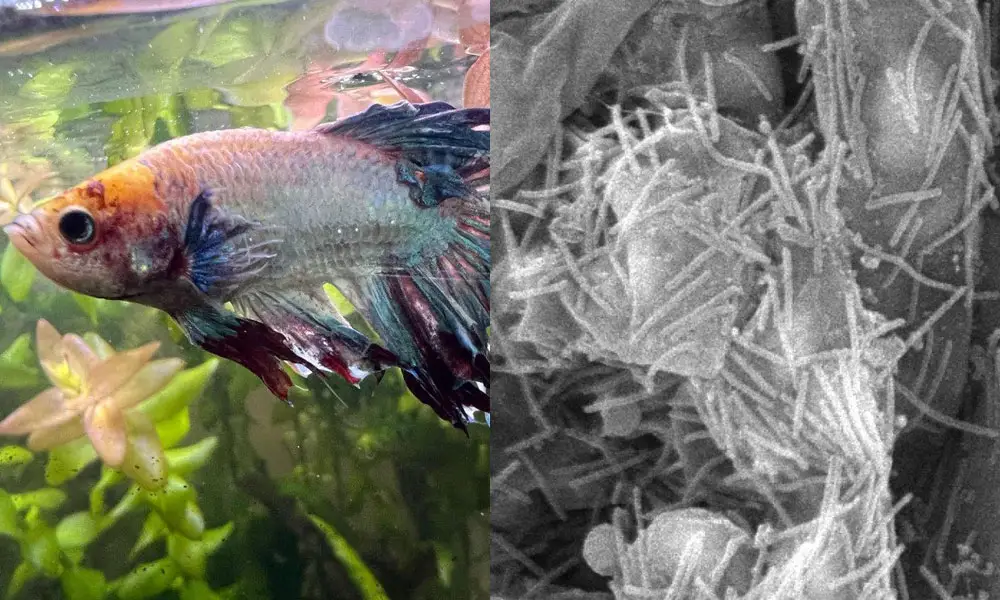
As mentioned before, columnaris is known by several different names. Some refer to it as the cotton wool disease. Others call it saddleback disease. It is also sometimes known as mouth rot or mouth fungus. However, it is NOT a fungal infection. It is, in fact, a bacterial infection that can be external or internal. It can also be either chronic or acute.
Why is it mistaken for a fungal infection? This is likely due to the presence of fungus-like lesions which can appear on your betta fish.
Some even refer to the infection as guppy disease (Tetrahymena spp.), given its white spots or patches on the head, fins, or gills seen in infected guppies.
However, columnaris is not just limited to these two species; it’s ubiquitous in most freshwater, both in aquariums and in the wild, particularly livebearers and catfish.
Regardless of the descriptive names, Flavobacterium columnare (formerly Flexibacter columnare ) is the causative agent responsible for Columnaris disease in betta fish, as well as other aquarium inhabitants.
This aerobic, opportunistic, Gram-negative bacterium can have a very high mortality rate, between 60 to 90% [1], especially in your young fish.
Like many other bacterial infections in bettas, Columnaris is highly contagious [2] that can be spread from fish to fish, infected equipment and water, and even food.
Research shows that columnaris can persist in water for long periods of time, up to 32 days [3], depending on the water conditions. High levels of hardness and dissolved organic compounds can increase the survival rate of columnaris.
Causes of Columnaris in Betta
Believe it or not, many diseases causing bacteria and parasites exist in virtually every aquarium, but they remain low in numbers and often don’t cause any harm. These become troublesome when the environment changes or your betta fish’s immune systems are not functioning properly.
The name of the game with all betta fish diseases ultimately comes down to stress. There are other ways that betta fish can catch this infection. However, you will still notice stress is a consistent factor among many of the most common columnaris bacteria causes:
- Injuries
- Poor water quality
- Poor diet
- Low dissolved oxygen
- High ammonia
- Inadequate filtration
- Overcrowding in a female betta sorority tank
- Too much light
Symptoms Of Columnaris in Bettas
As we mentioned earlier in this article, the presence of fluffy white spots or grayish spots or skin patches is the most visibly distinctive symptom of columnaris. If your betta fish has bright, beautiful colors, as is commonly the case, you should pay attention to areas that are paler in appearance. As time goes on, these spots can be yellow or brown.
Beyond this, there are a few more symptoms you are going to want to look out for:
Infected Gills
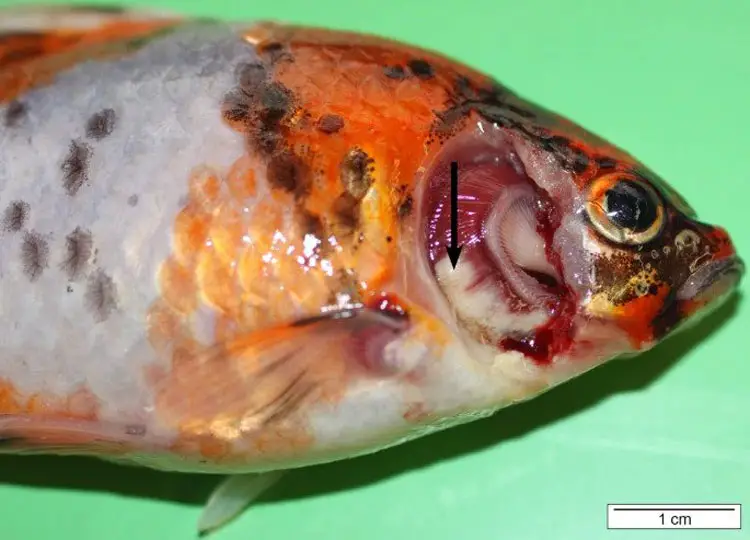
Often, Columnaris can attack your betta’s gill, resulting in the disintegration and discoloration of your betta’s gills. The gills can become light or dark brown as time passes.
When the Columnaris disease spreads quickly throughout the gill lamellae, your betta fish may die without any moldy or cottony lesions.
Labored Breathing
When the grill is damaged, it can cause a lack of oxygen. So, you will likely notice your betta breathing more rapidly than usual, and the fish might also gasp for breath at the water’s surface.
Skin Lesions & Ulcerations

Look for lesions that go all the way down the sides (near the dorsal fin) of your betta that resemble a white or grey “saddleback,” where the name saddleback disease comes from.
Quite often, these skin lesions may also be tinged red around the edges. When left untreated, your fish are likely to develop ulcers. Deeper ulcers are no joke — they can quickly result in major tissue loss and threaten the life of the betta.
Necrosis
As the infection worsens, the fish’s fins and gills can exhibit necrosis of cells and living tissue, which in turn will give the typical fin rot symptoms. Cottony-looking accumulations of bacteria usually accompany the frayed fins.
Cotton Mouth
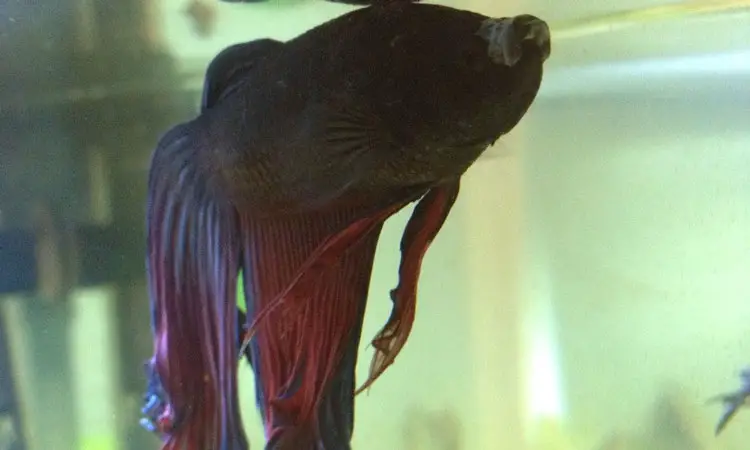
“Cotton mouth” is an indicator of columnaris occasionally, but it’s more likely associated with a fungal infection (Saprolegnia). In this instance, you will notice that your betta is displaying white cotton-like growth on the mouth.
Loss of Appetite
It is also very possible that if your betta has discomfort/infection around its mouth area, it isn’t going to be eating. A diminished appetite is definitely something to look for. Fish may also become stressed and lethargic.
Diagnosing
The first step in treating columnaris in betta fish is differentiating Columnaris disease from other infections, fungus in particular. To do so, you may take your sick betta to the veterinarian for a correct diagnosis, as it’s hard to tell columnaris from fungus without a microscope.
If you don’t have access to a veterinarian specializing in fish, you can use a magnifying glass instead.
Columnaris Vs. Fungus in Betta Fish
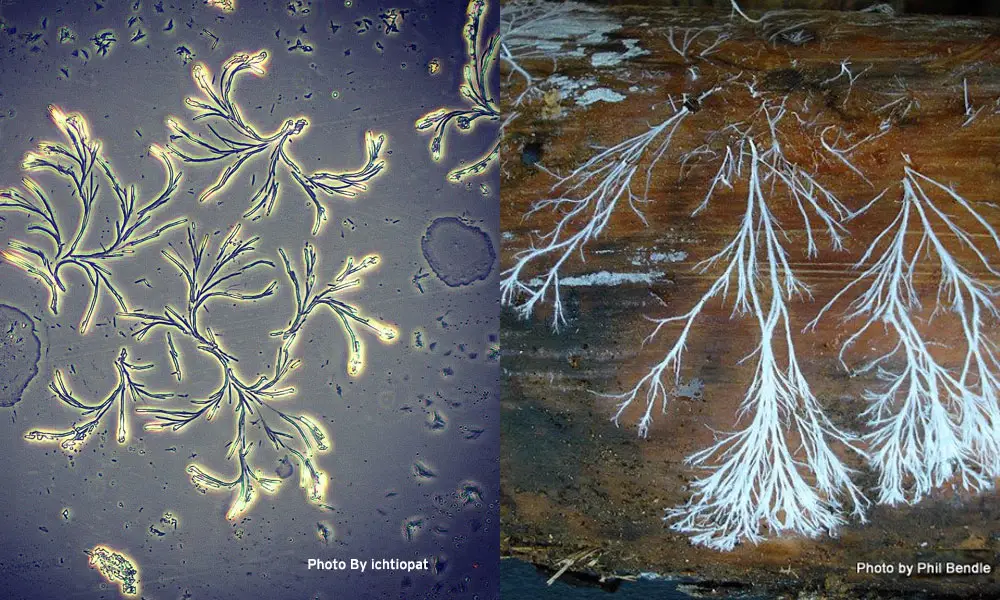
Upon closer inspection, you might notice the thin, hair-like structures on fish with Saprolegnia (referred to as fungus). These look similar to wood-decaying fungi in forests as well as wood in buildings. However, these structures are absent with Columnaris.
Another way to tell Fungus (Saprolegnia) and Columnaris apart is that the former usually grows on dead tissue. On the other hand, Columnaris requires living tissue to living and prosper.
You may need to be a bit of a detective. Treating Columnaris as fungus may have negative consequences, including death.
Treatment
Before we learn more about columnaris treatment, we should emphasize the morphological and biochemical characteristics of F. columnare.
| Characteristic | Description |
|---|---|
| Growth condition | Strictly aerobic |
| Gram-stain | Gram-negative |
| Morphology | Long, slender gliding rods |
| Capsule | Described to be absent or present depending on the adopted strain |
| H2S-production | Present |
| Degradation of crystalline cellulose | Absent |
Unlike many other facultative anaerobes like Saprolegnia (water mold), Aeromonas, Vibrio, and Edwardsiella, which can be controlled by giving additional oxygen support, Flavobacterium columnare is a strictly aerobic bacteria that requires oxygen to survive.
F. columnare (Columnaris) is also a nonhalophilic bacterium, meaning it can’t live in saltwater conditions. Therefore, salt is a 100% bulletproof solution.
Another quite important biochemical characteristic of F. columnare is its Gram-negative bacteria (GNB). That’s why Gram-positive antibiotics like API Melafix, Maracyn (Erythromycin), or Tetracycline are generally ineffective against a true Columnaris infection.
Lastly, this is an opportunistic warm water pathogen. According to AAP [4], Columnaris is most virulent between 85 F to 90 F. Therefore, raising your water temperature – a practical method to treat parasites – won’t affect columnaris in any way.
Now we have a much better understanding of columnaris, let’s move on to the treatment.
Treating bacterial infection in betta fish can be tricky, especially if you’re a first-time fish owner. Here’s a step-by-step guide with the medications and steps necessary to treat columnaris in betta fish.
Step 1: Do You Have a Quarantine Tank?
No matter your aquarium, you need a quarantine tank. But you may say, “I don’t need a separate hospital tank because there is only one fish in the aquarium, and he all look healthy.”
The reason is because most bacteria are commensal with healthy fish, meaning they live in and on the fish without causing any problems.
However, when fish are stressed – from shipping, poor water quality, etc. – their immune system can become weakened, which allows the bacteria to cause disease. Without the proper quarantine, columnaris can enter your main tank before you can detect it. Everything in the tank can be infected.
Second, we dose the medication based on the volume of the tank, and a 10-gallon smaller, bare tank is going to require a lower dose than, say, a 20-gallon tank. Money saved!
Most new fish keepers think it’s too much of a hassle to set up a quarantine tank, but when you consider the convenience of diagnosing and treatment and the potential costs of not doing it in the long run, the decision should be a no-brainer.
Also, ensure the hospital tank is far away from your main tank and never share the same equipment between the two, such as nets, siphons, or buckets.
Author notes: If columnaris has already infected your aquarium, we recommend treating the entire tank with medication.
Step 2: Check Your Water Parameters
The obvious next step is to check the water parameters. Strictly follow the parameters below. Remember, columnaris is an opportunistic bacterium that will take advantage of any form of stress.
- Water temperature: under 75 °F (24°C) (only during treatment)
- pH: 6.8 – 7.5
- Ammonia: 0 ppm
- Nitrite: 0 ppm
- Nitrate: Less than 30 ppm
- KH: 80-120 ppm
- GH: 50-130 ppm
Step 3: Aquarium Salt Bath
We love salt (NaCl) because it’s cheap, safe, highly effective, readily available, and never expires. Moreover, this useful remedy can be used in different concentrations depending on your needs.
- Contains one (1) API AQUARIUM SALT Freshwater Aquarium Salt 67-Ounce Box
- Promotes fish health and disease recovery with increased electrolytes
- Improves respiration for fish in freshwater aquariums
- Made from evaporated sea water for all-natural results
- Use when changing water, when setting up a new freshwater aquarium and when treating fish disease
To fight a mild columnaris infection, dissolve 1 teaspoon of aquarium salt per 5 gallons of water in a cup and use it to fill your quarantine tank. Then add your betta fish and let your betta soak in this solution for 15-20 minutes a day.
Repeat this process for 4-5 days. Try increasing the concentration to 1 teaspoon salt per 3 gallons (or higher) of water if there’s no improvement.
CAUTION: if your betta is already weak and stressed, the salt may be too much for him to handle. Make sure you watch him carefully during treatment. Salt can kill your betta fish by dehydration.
Step 4: Treat with Antibiotics
When salt baths have no effect, it’s time to bring out the big gun- a strong Methylene Blue & Potassium Permanganate bath.
When the Columnaris enter the bloodstream through the abraded skin or gills, they will cause deadly systemic infections faster without few other symptoms than if they were present externally on the skin.
In these cases, Methylene Blue (methylthioninium chloride) or Potassium Permanganate bath is an effective solution.
DO NOT use Potassium Permanganate (PP) if your betta fish has ulcerations. Also, DO NOT confuse Methylene Blue with Malachite Green.
Methylene Blue comes in both liquid and powder form, Kordon Methylene Blue is one of the most popular medications, and it is available in most pet stores.
To use Methylene Blue, follow these steps:
- Clean the hospital tank and remove any chemical filtration and UV sterilizers.
- Do 50% water changes and replace the filter carbon before each treatment.
- Dose 1 teaspoon (2.303% solution) per 5 gallons (double dose).
- Place the fish in this solution for 30 minutes (It’s important to keep the water in a warm area, sudden temperature changes can stress the fish.)
- Treatment should continue every other day for 10 days.
Methylene Blue can be used with salts to make a more effective columnaris betta treatment. Personally, I would use 1/4 teaspoon of salts per gallon.
How to Prevent Columnaris in Betta fish?
Going through some of the worst offenders for betta fish diseases columnaris, we can see that many of them are preventable on your end.
This extends to ensuring your tank is cleaned and well-maintained at all times. Giving your betta a good diet is also a sure way to keep them from fostering favorable infection conditions.
Checking on their stress levels and ensuring new fish are always quarantined after being brought home are great ways to lower the possibility of ever having to worry about any of this.
Final Thoughts
Cotton wool disease or columnaris disease is a serious and contagious bacterial infection that can occur in betta fish. If left untreated, columnaris can be fatal, but it is treatable if you catch it early enough.
At the end of the day, your best bet for dealing with Columnaris outbreaks is to prevent them entirely. Pay attention to your aquarium conditions and the overall health of your betta fish.
If columnaris does occur, treat it swiftly and with the correct medication before it becomes fatal. Good luck!
Article Sources:
- Columnaris Disease [University of Arkansas]
- Flavobacterium columnare/Myxobolus tilapiae Concurrent Infection in the Earthen Pond Reared Nile Tilapia (Oreochromis niloticus) during the Early Summer [Interdisciplinary Bio Central]
- Columnaris [Wikipedia]
- FISH COLUMNARIS | Fungus & Saprolegnia | Treatment & Prevention [AAP]
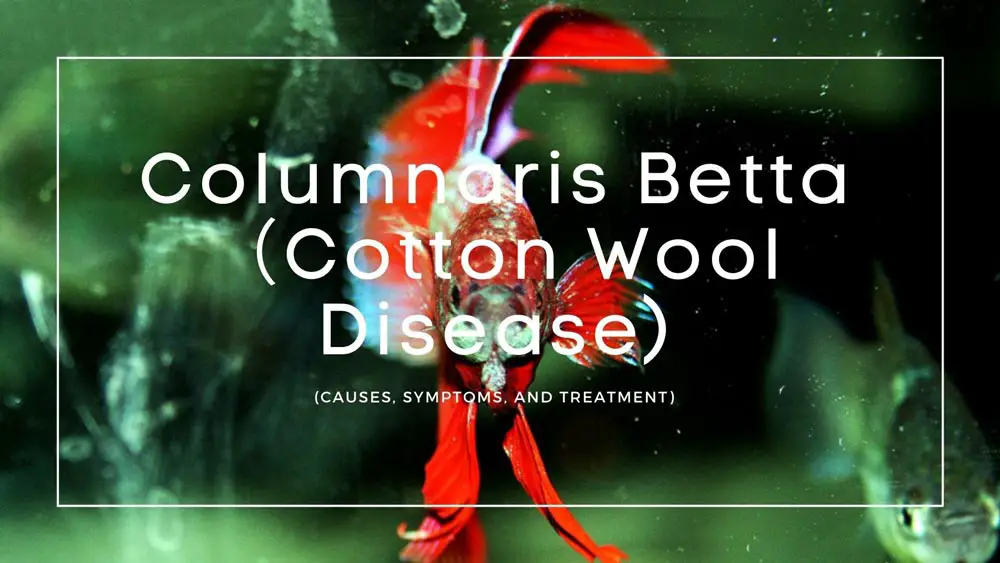






4 thoughts on “Columnaris in Betta Fish (Symptoms, Causes & Treatment)”
I’m not sure if my betta Phin has this. I have not been very good about changing the water regularly so today I did a full water change. I emptied all the old water out and replaced it with entirely new water from my faucet. I didn’t let the water sit out for long but I made sure it wasn’t freezing and made it so it felt room temperature. Ever since I put Phin back in his tank he has stuck his head in the pebbles at the bottom and hasn’t moved or eaten in hours. I also noticed that he has white, mold-like fuzz on the edge of his tail. It might have been there for more then just today and I hadn’t noticed it because of his dirty water, but I’m not sure. Please advice, I’m really worried about him, he has never acted this way before.
I am not recommending you have go treating for your betta if you’re unsure if he has it or not as these medications are harsh for any fish.
Just lost my betta Lucifer to this disease, but it seems like it was just secondary. Looks like he had some internal issues before. Had to put him down. Heartbroken,but better to see him being painfree and dead than suffering. I honestly do not know what else it was, I kept changing the water frequently and checked on him all the time. Really sad now… Was my first fish. Got some shrimp and snail now, will get another thank for bettas or a bigger 1 for all of them.
I am sorry to hear about your betta, we all get connected to at least one special fish in our lives.